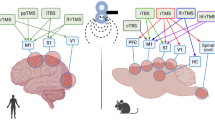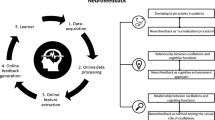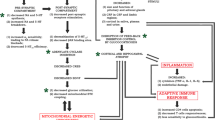Abstract
Rationale
Quetiapine is increasingly used for the treatment of patients with psychosis and bipolar disorder. However, the neurobiological mechanisms, which may account for the favourable risk/benefit profile of this drug, are not entirely understood.
Objectives
Transcranial magnetic stimulation was used to investigate the effects of acute and repeated administration of quetiapine on cortical excitability in healthy volunteers.
Materials and methods
Within a double-blind, placebo-controlled, randomized cross-over design motor threshold, intracortical inhibition, intracortical facilitation and cortical silent period were studied in 15 healthy volunteers before and after a single dose of placebo and 100 mg quetiapine. Additional measurements were performed after 5 days of daily intake of 100 mg quetiapine.
Results
We observed a significant prolongation of the cortical silent period after a single dose of quetiapine, whereas the placebo had no effects. After repeated administration, there was a trend towards CSP prolongation, which did not reach significance. However, plasma concentrations at this time point were relatively low, as measurements were performed 15 h after the last drug intake. Other parameters of cortical excitability remained unaffected.
Conclusions
By lengthening CSP without affecting MT, ICI and ICF, quetiapine demonstrates a unique neurophysiological profile which differs distinctively from brain excitability profiles of typical antipsychotics such as haloperidol. Provided that the CSP prolongation reflects the antipsychotic potential of quetiapine, TMS may be developed as a tool to monitor neurobiological effects of quetiapine treatment in schizophrenic patients and to explore the efficacy of other antipsychotic drugs with a similar mode of action.

Similar content being viewed by others
References
Brambilla P, Barale F, Soares JC (2003) Atypical antipsychotics and mood stabilization in bipolar disorder. Psychopharmacology (Berl) 166:315–332
Carlsson A (1988) The current status of the dopamine hypothesis of schizophrenia. Neuropsychopharmacology 1:179–186
Chen R, Samii A, Canos M, Wassermann EM, Hallett M (1997) Effects of phenytoin on cortical excitability in humans. Neurology 49:881–883
Daskalakis ZJ, Christensen BK, Chen R, Fitzgerald PB, Zipursky RB, Kapur S (2002) Evidence for impaired cortical inhibition in schizophrenia using transcranial magnetic stimulation. Arch Gen Psychiatry 59:347–354
Daskalakis ZJ, Christensen BK, Chen R, Fitzgerald PB, Zipursky RB, Kapur S (2003) Effect of antipsychotics on cortical inhibition using transcranial magnetic stimulation. Psychopharmacology (Berl) 170:255–262
Davey NJ, Puri BK, Lewis HS, Lewis SW, Ellaway PH (1997) Effects of antipsychotic medication on electromyographic responses to transcranial magnetic stimulation of the motor cortex in schizophrenia. J Neurol Neurosurg Psychiatry 63:468–473
Eichhammer P, Langguth B, Wiegand R, Kharraz A, Frick U, Hajak G (2003) Allelic variation in the serotonin transporter promoter affects neuromodulatory effects of a selective serotonin transporter reuptake inhibitor (SSRI). Psychopharmacology (Berl) 166:294–297
Eichhammer P, Wiegand R, Kharraz A, Langguth B, Binder H, Hajak G (2004) Cortical excitability in neuroleptic-naive first-episode schizophrenic patients. Schizophr Res 67:253–259
Faig J, Busse O (1996) Silent period evoked by transcranial magnetic stimulation in unilateral thalamic infarcts. J Neurol Sci 142:85–92
Fitzgerald PB, Brown TL, Daskalakis ZJ, Kulkarni J (2002a) A transcranial magnetic stimulation study of inhibitory deficits in the motor cortex in patients with schizophrenia. Psychiatry Res 114:11–22
Fitzgerald PB, Brown TL, Daskalakis ZJ, Kulkarni J (2002b) A transcranial magnetic stimulation study of the effects of olanzapine and risperidone on motor cortical excitability in patients with schizophrenia. Psychopharmacology (Berl) 162:74–81
Inghilleri M, Berardelli A, Cruccu G, Manfredi M (1993) Silent period evoked by transcranial stimulation of the human cortex and cervicomedullary junction. J Physiol 466:521–534
Kapur S, Seeman P (2000) Antipsychotic agents differ in how fast they come off the dopamine D2 receptors. Implications for atypical antipsychotic action. J Psychiatry Neurosci 25:161–166
Keating GM, Robinson DM (2007) Quetiapine: a review of its use in the treatment of bipolar depression. Drugs 67:1077–1095
Kinon BJ, Noordsy DL, Liu-Seifert H, Gulliver AH, scher-Svanum H, Kollack-Walker S (2006) Randomized, double-blind 6-month comparison of olanzapine and quetiapine in patients with schizophrenia or schizoaffective disorder with prominent negative symptoms and poor functioning. J Clin Psychopharmacol 26:453–461
Kujirai T, Caramia MD, Rothwell JC, Day BL, Thompson PD, Ferbert A, Wroe S, Asselman P, Marsden CD (1993) Corticocortical inhibition in human motor cortex. J Physiol 471:501–519
Langguth B, Eichhammer P, Zowe M, Marienhagen J, Spiessl H, Hajak G (2006) Neuronavigated transcranial magnetic stimulation and auditory hallucinations in a schizophrenic patient: monitoring of neurobiological effects. Schizophr Res 84:185–186
Langguth B, Bauer E, Feix S, Landgrebe M, Binder H, Sand P, Hajak G, Eichhammer P (2007) Modulation of human motor cortex excitability by the cholinesterase inhibitor rivastigmine. Neurosci Lett 415:40–44
Maeda F, Keenan JP, Pascual-Leone A (2000) Interhemispheric asymmetry of motor cortical excitability in major depression as measured by transcranial magnetic stimulation. Br J Psychiatry 177:169–173
Moll GH, Heinrich H, Trott GE, Wirth S, Bock N, Rothenberger A (2001) Children with comorbid attention-deficit-hyperactivity disorder and tic disorder: evidence for additive inhibitory deficits within the motor system. Ann Neurol 49:393–396
Munchau A, Orth M, Rothwell JC, Di Lazzaro V, Oliviero A, Profice P, Tonali P, Pramstaller PP, Bhatia KP (2002) Intracortical inhibition is reduced in a patient with a lesion in the posterolateral thalamus. Mov Disord 17:208–212
Pascual-Leone A, Manoach DS, Birnbaum R, Goff DC (2002) Motor cortical excitability in schizophrenia. Biol Psychiatry 52:24–31
Pira L, Mongeau R, Pani L (2004) The atypical antipsychotic quetiapine increases both noradrenaline and dopamine release in the rat prefrontal cortex. Eur.J Pharmacol. 504:61–64
Riedel M, Muller N, Strassnig M, Spellmann I, Engel RR, Musil R, Dehning S, Douhet A, Schwarz MJ, Moller HJ (2005) Quetiapine has equivalent efficacy and superior tolerability to risperidone in the treatment of schizophrenia with predominantly negative symptoms. Eur Arch Psychiatry Clin Neurosci 255:432–437
Sacchetti E, Panariello A, Regini C, Valsecchi P (2004) Quetiapine in hospitalized patients with schizophrenia refractory to treatment with first-generation antipsychotics: a 4-week, flexible-dose, single-blind, exploratory, pilot trial. Schizophr Res 69:325–331
Stahl SM (2000) Essential Psychopharmacology. Cambridge University Press
Tandon R (2004) Quetiapine has a direct effect on the negative symptoms of schizophrenia. Hum Psychopharmacol 19:559–563
Tergau F, Wischer S, Somal HS, Nitsche MA, Mercer AJ, Paulus W, Steinhoff BJ (2003) Relationship between lamotrigine oral dose, serum level and its inhibitory effect on CNS: insights from transcranial magnetic stimulation. Epilepsy Res 56:67–77
Vollenweider FX, Geyer MA (2001) A systems model of altered consciousness: integrating natural and drug-induced psychoses. Brain Res Bull 56:495–507
Waldvogel D, van Gelderen P, Muellbacher W, Ziemann U, Immisch I, Hallett M (2000) The relative metabolic demand of inhibition and excitation. Nature 406:995–998
Ziemann U, Lonnecker S, Steinhoff BJ, Paulus W (1996) Effects of antiepileptic drugs on motor cortex excitability in humans: a transcranial magnetic stimulation study. Ann Neurol 40:367–378
Ziemann U, Paulus W, Rothenberger A (1997a) Decreased motor inhibition in Tourette’s disorder: evidence from transcranial magnetic stimulation. Am J Psychiatry 154:1277–1284
Ziemann U, Tergau F, Bruns D, Baudewig J, Paulus W (1997b) Changes in human motor cortex excitability induced by dopaminergic and anti-dopaminergic drugs. Electroencephalogr Clin Neurophysiol 105:430–437
Ziemann U, Steinhoff BJ, Tergau F, Paulus W (1998) Transcranial magnetic stimulation: its current role in epilepsy research. Epilepsy Res 30:11–30
Ziemann U, Hallett M, Belmaker RH (2000) Basic neurophysiological studies with TMS. In: George MS (ed) Transcranial magnetic stimulation in neuropsychiatry. American Psychiatric Press, Inc., Washington, DC, pp 45–98
Acknowledgements
The authors wish to thank Sandra Pfluegl and Helene Niebling for technical assistance and Astra Zeneca, Germany, for funding of the study.
Conflict of interest statement
The study has been funded by a grant from Astra Zeneca. None of the authors has any further conflict of interest with respect to this study. The company Astra Zeneca did not have any influence on the conduct of the study, the collection, management, analysis, and interpretation of data, the writing of the manuscript or the decision to submit the manuscript for publication.
Author information
Authors and Affiliations
Corresponding author
Additional information
Berthold Langguth, Peter Eichhammer contributed equally to the manuscript.
Rights and permissions
About this article
Cite this article
Langguth, B., Eichhammer, P., Spranz, C. et al. Modulation of human motor cortex excitability by quetiapine. Psychopharmacology 196, 623–629 (2008). https://doi.org/10.1007/s00213-007-1000-z
Received:
Accepted:
Published:
Issue Date:
DOI: https://doi.org/10.1007/s00213-007-1000-z




